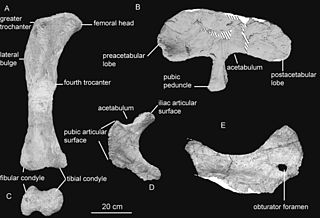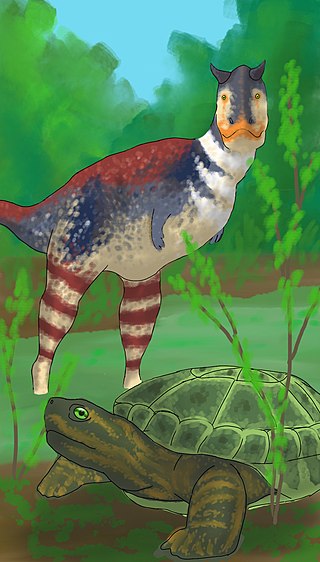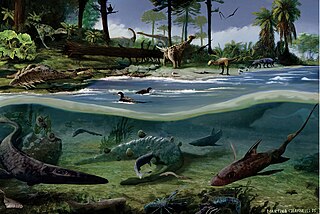
Carnotaurus is a genus of theropod dinosaur that lived in South America during the Late Cretaceous period, probably sometime between 71 and 69 million years ago. The only species is Carnotaurus sastrei. Known from a single well-preserved skeleton, it is one of the best-understood theropods from the Southern Hemisphere. The skeleton, found in 1984, was uncovered in the Chubut Province of Argentina from rocks of the La Colonia Formation. Carnotaurus is a derived member of the Abelisauridae, a group of large theropods that occupied the large predatorial niche in the southern landmasses of Gondwana during the late Cretaceous. Within the Abelisauridae, the genus is often considered a member of the Brachyrostra, a clade of short-snouted forms restricted to South America.

Rocasaurus is a genus of titanosaurian sauropod that lived in South America. Rocasaurus was discovered in Argentina in 2000, within the Allen Formation which is dated to be middle Campanian to early Maastrichtian in age. This genus grew up to 8 metres (26 ft) long, making it one of the smaller sauropods. It seems to be closely related to saltasaurid dinosaurs, like Saltasaurus and Neuquensaurus.
The Cerro Barcino Formation is a geological formation in South America whose strata span the Early Cretaceous to the earliest Late Cretaceous. The top age for the formation has been estimated to be Cenomanian. Earlier estimates placed the formation until the Campanian.
The Bajo Barreal Formation is a geological formation in the Golfo San Jorge Basin of Chubut and Santa Cruz, Argentina whose strata date back to the Middle Cenomanian to Late Turonian. The formation was first described by Teruggi & Rossetto in 1963. The sandstones, claystones, mudstones, conglomerates and tuff were deposited in a fluvial environment. The upper part of formation is laterally equivalent to the Yacimiento El Trébol and Meseta Espinosa Formation and the lower part to the Laguna Palacios, Cañadón Seco and Comodoro Rivadavia Formations. The Bajo Barreal Formation is a reservoir rock in the Golfo San Jorge Basin.

The Allen Formation is a geological formation in Argentina whose strata date back to the Late Cretaceous (middle Campanian to early Maastrichtian. Dinosaur remains are among the fossils that have been recovered from the formation. Indeterminate chelid remains and other vertebrates have also been discovered in this formation.
The Angostura Colorada Formation is a Campanian to Maastrichtian geologic formation of the Neuquén Basin and North Patagonian Massif in the Río Negro Province of Argentina. Dinosaur remains diagnostic to the genus level are among the fossils that have been recovered from the formation.

Patagoniaemys is an extinct genus of stem turtle which existed in central Patagonia, Chubut Province, Argentina during the late Cretaceous epoch. It is known from skull fragments and several postcranial elements including a nearly complete vertebral column recovered from the La Colonia Formation. It was first named by Juliana Sterli and Marcelo S. de la Fuente in 2011, and the type species is Patagoniaemys gasparinae.

The Snow Hill Island Formation is an Early Maastrichtian geologic formation found on James Ross Island, James Ross Island group, Antarctica. Remains of a paravian theropod Imperobator antarcticus have been recovered from it, as well as the elasmarian ornithopods Trinisaura santamartaensis, Biscoveosaurus and Morrosaurus antarcticus, the ankylosaurian Antarctopelta oliveroi, and the shark Notidanodon sp. Alongside these described genera are also the remains of indeterminate elasmosaurids, lithostrotian titanosaurs and an indeterminate pterosaur.
Reigitherium was a mammal that lived during the Late Cretaceous, in the. Its fossils have been found in the Los Alamitos and the La Colonia Formations of Argentina.
Coloniatherium is a meridiolestid mammal from the Late Cretaceous of Argentina. The single species, Coloniatherium cilinskii, was a large member of the family Mesungulatidae.

The Malargüe Group is a group of geologic formations of the Neuquén Basin of the Mendoza, Neuquén, Río Negro and La Pampa Provinces in northern Patagonia, Argentina. The formations of the Malargüe Group range in age between the middle Campanian to Deseadan, an Oligocene age of the SALMA classification, straddling the Cretaceous–Paleogene boundary, about 79 million to 30 million years in age. The group overlies the older Neuquén Group, separated by an unconformity dated to 79 Ma. The rocks of the Malargüe Group comprise both marine and continental deposits which are over 400 m (1312 ft) thick in total.

Kawanectes is a genus of elasmosaurid plesiosaur, a type of long-necked marine reptile, that lived in the marginal marine environment of Late Cretaceous Patagonia. It contains one species, K. lafquenianum, described in 2016 by O'Gorman.
The Cañadón Asfalto Basin is an irregularly shaped sedimentary basin located in north-central Patagonia, Argentina. The basin stretches from and partly covers the North Patagonian Massif in the north, a high forming the boundary of the basin with the Neuquén Basin in the northwest, to the Cotricó High in the south, separating the basin from the Golfo San Jorge Basin. It is located in the southern part of Río Negro Province and northern part of Chubut Province. The eastern boundary of the basin is the North Patagonian Massif separating it from the offshore Valdés Basin and it is bound in the west by the Patagonian Andes, separating it from the small Ñirihuau Basin.

The Lefipán Formation is a Maastrichtian to Danian, straddling the Cretaceous-Paleogene boundary, geologic formation of the Cañadón Asfalto Basin in Chubut Province, Patagonia, Argentina. The up to 380 metres (1,250 ft) thick stratigraphic unit comprises mudstones, sandstones, siltstones and conglomerates, sourced from the North Patagonian Massif and deposited in a deltaic to shallow marine environment with a strong tidal influence. The basin that in those times was connected to the widening South Atlantic Ocean with a seaway connection to the Austral Basin and possibly with the Pacific Ocean.

Meiolaniformes is an extinct clade of stem-group turtles, defined as all taxa more closely related to Meiolania than to Cryptodira and Pleurodira. It is known from the Early Cretaceous to the Holocene of Australia, Oceania and South America. Some Eurasian taxa have been suggested to be part of the group, but this is disputed.

The Dorotea Formation is a geological formation in the Río de Las Chinas Valley of the Magallanes Basin in Patagonian Chile whose strata date back to the Campanian to Maastrichtian of the Late Cretaceous.
Chubutinectes is an extinct genus of elasmosaurid plesiosaur from the Late Cretaceous La Colonia Formation of Argentina. The genus contains a single species, C. carmeloi, known from a partial skeleton and associated gastroliths.
The Cañadón Asfalto Formation is a geological formation which dates to the Toarcian age of the Early Jurassic period of Argentina. The rocks of the formation preserve a diverse biota, including plants, dinosaurs, invertebrates, mammals and pterosaurs, among others. The formation is divided into two members: the lower Las Chacritas Member, and the overlying Puesto Almada member, though the latter has also been assigned to the overlying Cañadón Calcáreo Formation by some authors. The members are typically composed of fluvial-lacustrine deposits consisting of sandstones and shales, with a limestone carbonate evaporitic sequence also being present in the lower of the two.

Titanomachya is an extinct genus of titanosaurian sauropod dinosaur from the Late Cretaceous La Colonia Formation of Argentina. The genus contains a single species, T. gimenezi. It is a relatively small titanosaur, weighing around 7.8 tonnes.
Koleken is a genus of carnotaurin abelisaurid from the Maastrichtian La Colonia Formation in the Chubut Province of Argentina. The type and only species is K. inakayali, known from one immature specimen about six years old in minimum age.



















